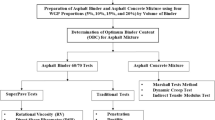Abstract
The effect of E-type glass fibre on the strength and durability of gypsum binder composites was studied under different climatic conditions and by accelerated methods. After 50 cycles of wetting and drying at 60°C an irregular deposition of gypsum binder products was found at the surface of glass fibres. Durability of E-type glass (borosilicate) fibres employed as reinforcement in the gypsum binder composites was examined after immersion into aqueous extract of gypsum binder at temperature 27° to 60°C. The exposed glass fibres were studied by scanning electron microscope and by weight loss determination. Deterioration of E-type glass fibres was observed at 50° and 60°C on exposure to aqueous gypsum binder extract which is directly related to the durability of gypsum binder composites. It is concluded that gypsum binder composites should be used under 50°C.
Résumé
L’effet de la fibre de verre de type E sur la force et la durabilité des matériaux liants à base de gypse a été étudié sous différentes conditions climatiques et par des méthodes accélérées. Après 50 cycles de mouillage et séchage à 60°C, une déposition irrégulière de liants à base de gypse a été dévouverte à la surface des fibres de verre. La durabilité des fibres de verre (borosilicate) de type E utilisées afin de renforcer les matériaux liants à base de gypse a été examinée après immersion dans un extrait aqueux du liant à base de gypse à une température de 27 à 60°C. Les fibres de verre exposées ont été scannées et étudiées à l’aide d’un microscope électronique et leur perte de poids a été déterminée. Une détérioration des fibres de verre de type E a été observée à 50 et 60°C après exposition à l’extrait aqueux du liant à base de gypse, qui est directement lié à la durabilité des liants à base de gypse. En conclusion, les composites liants à base de gypse doivent être utilisés à une température inférieure à 50°C.
Similar content being viewed by others
References
Singh, M. and Garg, M., ‘Investigation of a durable gypsum binder for building materials’,Construction and Building Materials 6 (1992) 52–56.
Singh, M., ‘Effect of phosphogypsum impurities on the morphology and physical characteristics of set plaster’, 9th CIB Congress, Stockholm, Sweden, August 1983, (The National Swedish Institute for Building Research, Gavle) 239–50.
Singh, M., ‘Utilization of phosphogypsum for building materials’, Building Research Note No. 9, (1988), CBRI Publication, Roorkee, India 52–56.
Singh, M. and Garg, M., ‘Glass fibre reinforced water-resistant gypsum based composites’,Cement and Concrete Composites 14 (1992) 23–32.
Singh, M. and Garg, M., ‘Gypsum based fibre reinforced composites, An alternative to timber’Construction and Building Materials 8 (3) (1994) 155–160.
Singh, M. and Garg, M., ‘An alternative to timber’,Indian Concrete J. 67 (2) (1993) 78–84.
Ali, M. A. and Grimer, F. J., ‘Mechanical properties of glass fibre reinforced gypsum’, Current Paper No. 33/69 (Building Research Station, London, 1969).
Grimer, F. J. and Ali, M. A., ‘The strength of cements reinforced with glass fibres’,Mag. of Con. Res. 21 (66) (1969) 23–30.
Burkard, E. A. and Segada, J. J., ‘Fire resistant gypsum boards’,Chem. Abstr. 104 (1986) 11502t.
Ferronskaya, A. V. and Andrev, E. I., ‘Glass fibre reinforced composite materials made from water resistant gypsum binder’,Stroit. Matr. 2 (1982) 17–18.
Bijen, J. ‘Polymer modified glass fibre reinforced gypsum’, in the ‘High performance Fibre Cement Composites’, London, 1992 (RILEM, F & FN Spon, London) 100–114.
Kulkarni, B. N., Narain, S. N. and Chandawat, B. S., ‘Low cost houses from argillacious grade gypsum in arid zone of Rajasthan’,Transaction of Indian Desert Technology 2 (1977) 121–8.
Majumdar, A. J., West, J. M. and Larner, L. J., ‘Properties of glass fibre in cement environment’,BRE Establishment Research Series Fibre Reinforced Materials 2 (1978) CP 24/77.
Ghorab, H. Y. and Kishar, E. A., ‘Studies on stability of the calcium sulphoaluminate hydrate—Part 1: Effect of temperature on the stability of ettringite in pure water’,Cement and Concrete Research 75 (1) (1985) 93–99.
Author information
Authors and Affiliations
Rights and permissions
About this article
Cite this article
Singh, M., Garg, M. Fibre reinforced gypsum binder composite, its microstructure and durability. Mat. Struct. 33, 525–528 (2000). https://doi.org/10.1007/BF02480530
Received:
Accepted:
Issue Date:
DOI: https://doi.org/10.1007/BF02480530




